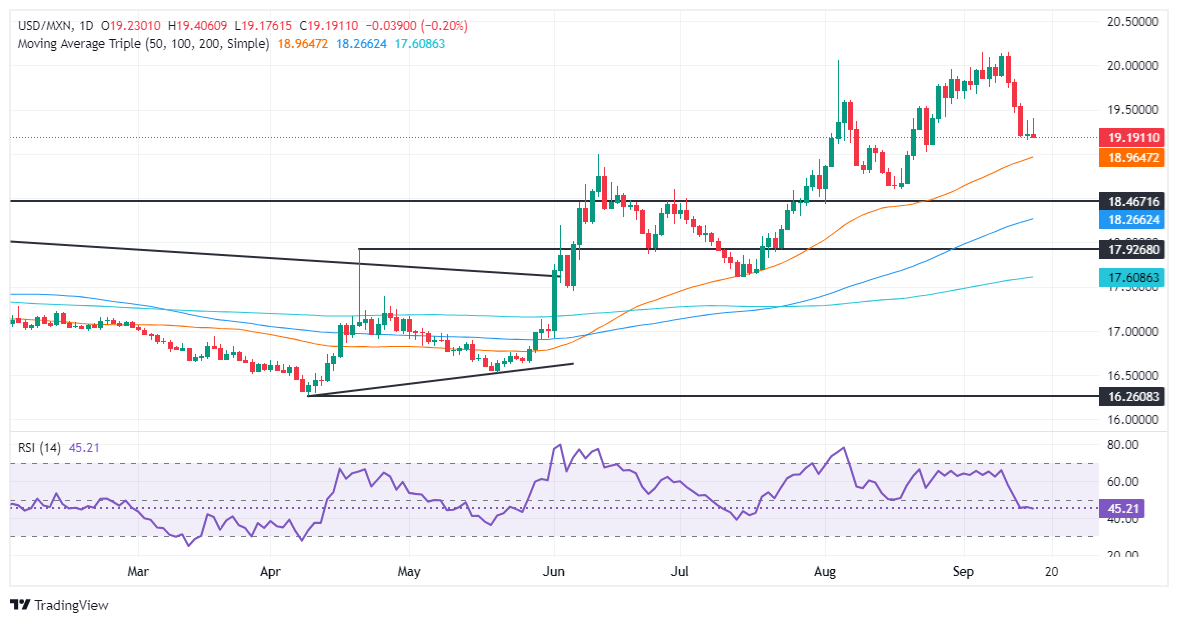- Mexican Peso strenghtens despite US Retail Sales, Industrial Production beat estimates.
- Mexico’s Q2 Aggregate Demand and Private Spending data will be released Wednesday, while the Fed’s rate decision looms.
- US Dollar Index climbs 0.20% to 100.92, as traders maintain 61% odds for a 50 bps Fed rate cut.
The Mexican Peso erased some of its losses against the US Dollar, gains some 0.40% after US Retail Sales data was better than expected. Despite that, expectations that the Federal Reserve (Fed) will cut rates by 50 basis points (bps) remained unchanged as the Fed begins its two-day meeting. The USD/MXN trades at 19.11 after hitting a daily high of 19.40.
The US Commerce Department revealed that August Retail Sales fared better than the consensus. The data revealed that consumers remain resilient even though hiring and wage growth show signs of moderation. Other data showed that Industrial Production in August rose after posting a contraction in July.
Following the data, the Greenback extended its gains, as seen by the USD/MXN pair. According to the US Dollar Index (DXY), it climbed some 0.20% to 100.92, even though odds for a 50 bps rate cut by the Fed remained at 61%, while the chances for a quarter of a percentage point are 39%.
In the meantime, the Atlanta Fed GDP Now Index, which calculates estimates for Q3 Gross Domestic Product (GDP) figures, rose from 2.5% to 3%.
On Wednesday, Mexico’s economic docket will feature Aggregate Demand for Q2 alongside Private Spending figures. Across the border, the US economic schedule will feature housing data ahead of the Federal Open Market Committee (FOMC) monetary policy decision. After that, Fed Chairman Jerome Powell will cross the wires.
Daily digest market movers: Mexican Peso advances despite solid US data
- USD/MXN would continue to be driven by market mood and expectations for a bigger Fed rate cut.
- US Retail Sales in August rose 0.1% MoM above estimates of -0.2%. Every year, the figures expanded by 2.1%, down from 2.9% in July.
- Industrial Production rose by 0.8% MoM in August, up from a -0.9% contraction in the previous month.
- Data from the Chicago Board of Trade suggests the Fed will cut at least 111 basis points this year, according to the fed funds rate futures contract for December 2024.
USD/MXN technical outlook: Mexican Peso rises as USD/MXN drops below 19.20
The USD/MXN remains upwardly biased despite dipping to 19.15 last week. Momentum suggests that the exotic pair might consolidate in the near term as depicted by the Relative Strength Index (RSI) turning flat.
That said, if USD/MXN climbs above 19.50, the next resistance would be the 20.00 psychological figure. Conversely, if USD/MXN drops below 19.15, key support levels emerge like the August 23 daily low of 19.02, ahead of the 50-day Simple Moving Average (SMA) at 18.99.

Fed FAQs
Monetary policy in the US is shaped by the Federal Reserve (Fed). The Fed has two mandates: to achieve price stability and foster full employment. Its primary tool to achieve these goals is by adjusting interest rates. When prices are rising too quickly and inflation is above the Fed’s 2% target, it raises interest rates, increasing borrowing costs throughout the economy. This results in a stronger US Dollar (USD) as it makes the US a more attractive place for international investors to park their money. When inflation falls below 2% or the Unemployment Rate is too high, the Fed may lower interest rates to encourage borrowing, which weighs on the Greenback.
The Federal Reserve (Fed) holds eight policy meetings a year, where the Federal Open Market Committee (FOMC) assesses economic conditions and makes monetary policy decisions. The FOMC is attended by twelve Fed officials – the seven members of the Board of Governors, the president of the Federal Reserve Bank of New York, and four of the remaining eleven regional Reserve Bank presidents, who serve one-year terms on a rotating basis.
In extreme situations, the Federal Reserve may resort to a policy named Quantitative Easing (QE). QE is the process by which the Fed substantially increases the flow of credit in a stuck financial system. It is a non-standard policy measure used during crises or when inflation is extremely low. It was the Fed’s weapon of choice during the Great Financial Crisis in 2008. It involves the Fed printing more Dollars and using them to buy high grade bonds from financial institutions. QE usually weakens the US Dollar.
Quantitative tightening (QT) is the reverse process of QE, whereby the Federal Reserve stops buying bonds from financial institutions and does not reinvest the principal from the bonds it holds maturing, to purchase new bonds. It is usually positive for the value of the US Dollar.





